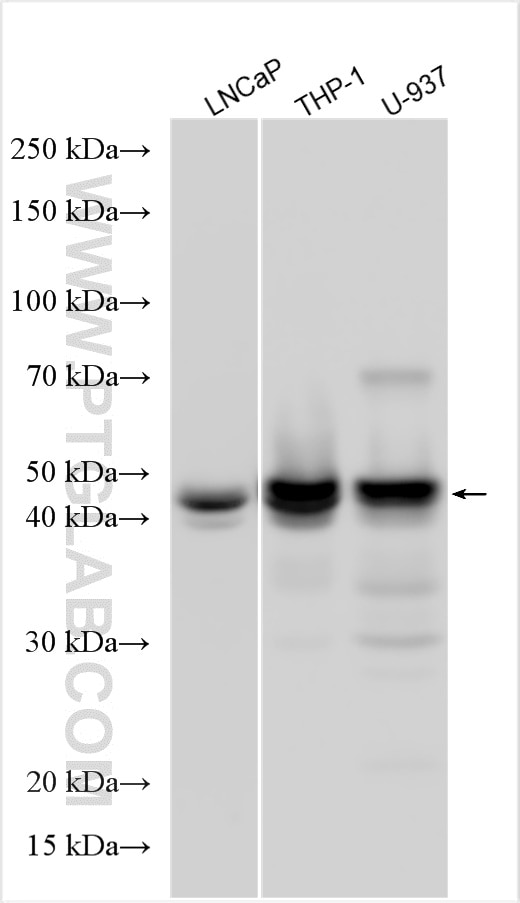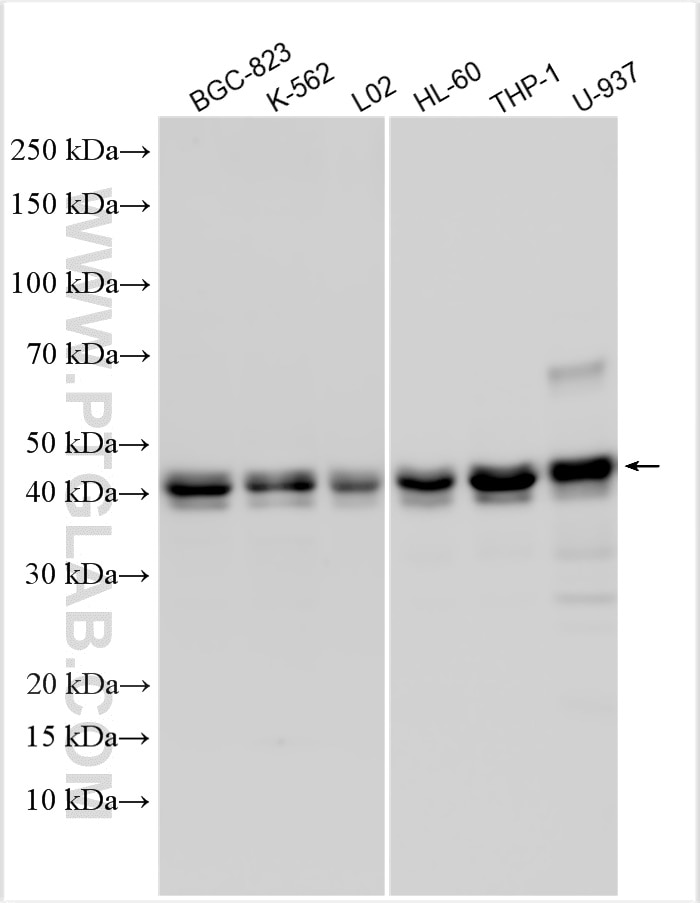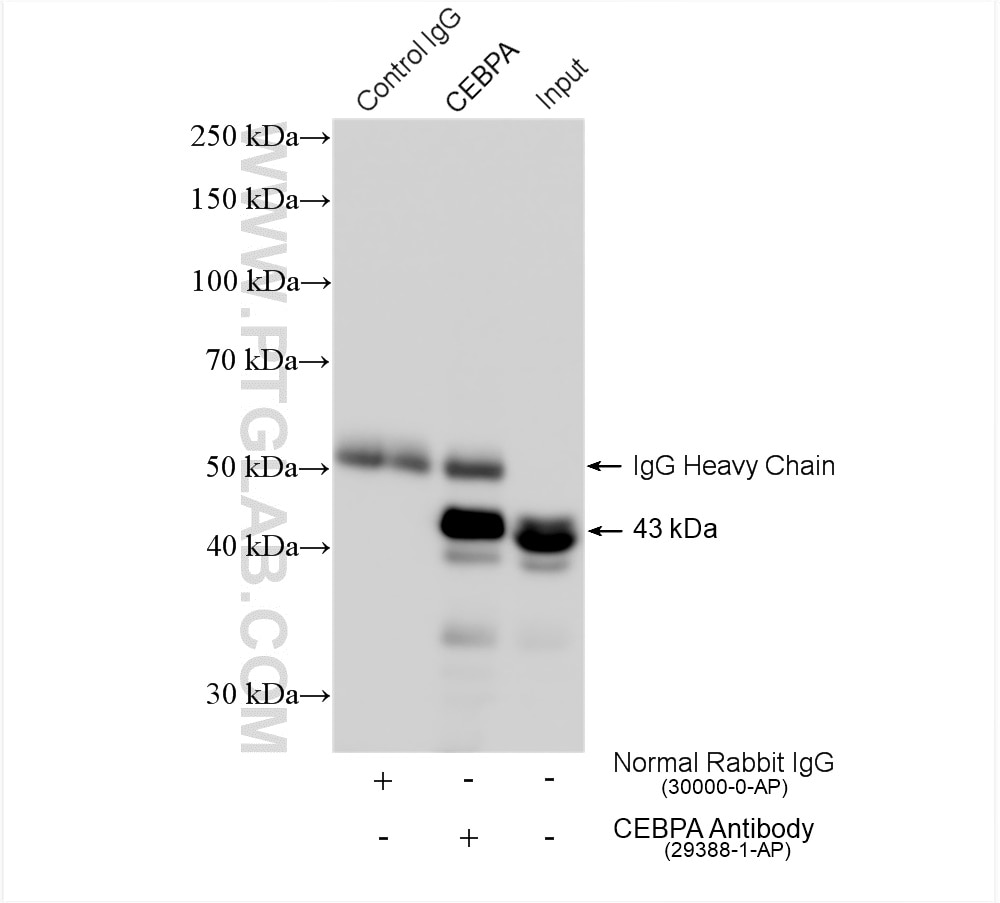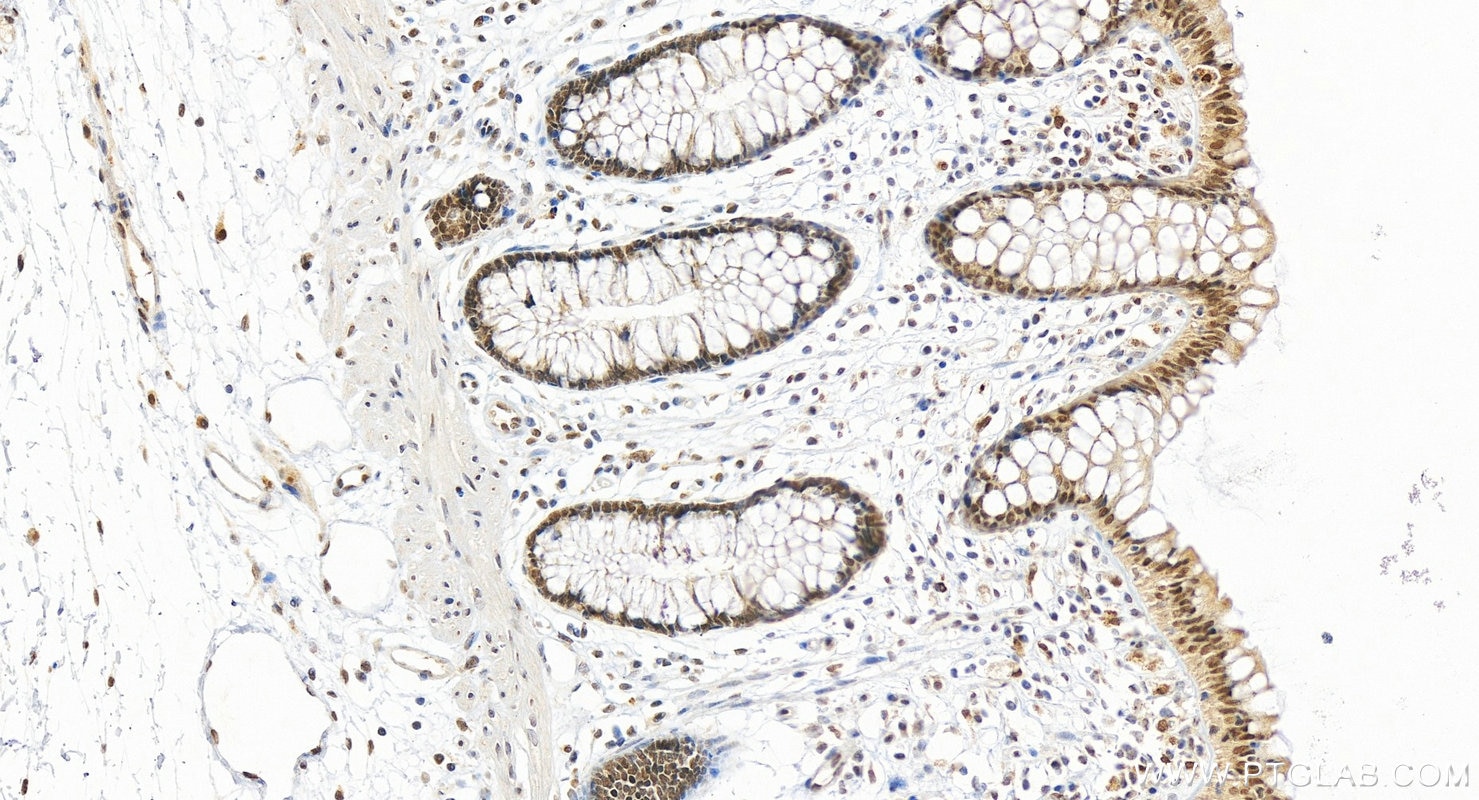Anticorps Polyclonal de lapin anti-CEBP Alpha/CEBPA
CEBP Alpha/CEBPA Polyclonal Antibody for WB, IHC, IF/ICC, IP, ELISA
Hôte / Isotype
Lapin / IgG
Réactivité testée
Humain et plus (2)
Applications
WB, IHC, IF/ICC, IP, ELISA
Conjugaison
Non conjugué
N° de cat : 29388-1-AP
Synonymes
Galerie de données de validation
Applications testées
| Résultats positifs en WB | cellules BGC-823, cellules HL-60, cellules K-562, cellules L02, cellules LNCaP, cellules THP-1, cellules U-937 |
| Résultats positifs en IP | cellules THP-1, |
| Résultats positifs en IHC | tissu de côlon humain, il est suggéré de démasquer l'antigène avec un tampon de TE buffer pH 9.0; (*) À défaut, 'le démasquage de l'antigène peut être 'effectué avec un tampon citrate pH 6,0. |
| Résultats positifs en IF/ICC | cellules A431, |
Dilution recommandée
| Application | Dilution |
|---|---|
| Western Blot (WB) | WB : 1:1000-1:6000 |
| Immunoprécipitation (IP) | IP : 0.5-4.0 ug for 1.0-3.0 mg of total protein lysate |
| Immunohistochimie (IHC) | IHC : 1:500-1:2000 |
| Immunofluorescence (IF)/ICC | IF/ICC : 1:200-1:800 |
| It is recommended that this reagent should be titrated in each testing system to obtain optimal results. | |
| Sample-dependent, check data in validation data gallery | |
Applications publiées
| KD/KO | See 1 publications below |
| WB | See 17 publications below |
| IHC | See 1 publications below |
| IF | See 2 publications below |
Informations sur le produit
29388-1-AP cible CEBP Alpha/CEBPA dans les applications de WB, IHC, IF/ICC, IP, ELISA et montre une réactivité avec des échantillons Humain
| Réactivité | Humain |
| Réactivité citée | rat, Humain, souris |
| Hôte / Isotype | Lapin / IgG |
| Clonalité | Polyclonal |
| Type | Anticorps |
| Immunogène | CEBP Alpha/CEBPA Protéine recombinante Ag29947 |
| Nom complet | CCAAT/enhancer binding protein (C/EBP), alpha |
| Masse moléculaire calculée | 38 kDa |
| Poids moléculaire observé | 40-45 kDa |
| Numéro d’acquisition GenBank | NM_004364 |
| Symbole du gène | CEBPA |
| Identification du gène (NCBI) | 1050 |
| Conjugaison | Non conjugué |
| Forme | Liquide |
| Méthode de purification | Purification par affinité contre l'antigène |
| Tampon de stockage | PBS with 0.02% sodium azide and 50% glycerol |
| Conditions de stockage | Stocker à -20°C. Stable pendant un an après l'expédition. L'aliquotage n'est pas nécessaire pour le stockage à -20oC Les 20ul contiennent 0,1% de BSA. |
Informations générales
CEBPA and its isoforms play important roles in lineage determination and gene activation in a variety of cell types by activating transcription from lineage-specific promoters. CEBPA is a DNA-binding protein that recognizes two different motifs: the CCAAT homology common to many promoters and the enhanced core homology common to many enhancers. In hematopoiesis, C/EBPa is a key factor in driving the development of myeloid cells interacting with a variety of factors, including c-Myc, PU.1, and microRNAs. It can also form heterodimers with the related proteins CEBP-beta and CEBP-gamma. The encoded protein has been shown to bind to the promoter and modulate the expression of the gene encoding leptin which plays an important role in body weight homeostasis. CEBPA can interact with CDK2 and CDK4, thereby inhibiting these kinases and causing growth arrest in cultured cells. Several pathways have been implicated as the means by which CEBPA mediates cell cycle arrest and proliferation, including p21, cyclin-dependent kinases and the E2F complex via c-Myc. The calcualted molecular weight of CEBPA is 38 kDa, but modified CEBPA is about 42 kDa (PMID: 19623175).
Protocole
| Product Specific Protocols | |
|---|---|
| WB protocol for CEBP Alpha/CEBPA antibody 29388-1-AP | Download protocol |
| IHC protocol for CEBP Alpha/CEBPA antibody 29388-1-AP | Download protocol |
| IF protocol for CEBP Alpha/CEBPA antibody 29388-1-AP | Download protocol |
| IP protocol for CEBP Alpha/CEBPA antibody 29388-1-AP | Download protocol |
| Standard Protocols | |
|---|---|
| Click here to view our Standard Protocols |
Publications
| Species | Application | Title |
|---|---|---|
J Agric Food Chem Enzymatic Synthesis and Evaluation of Eight Methylated Quercetin Products: In Vitro Chemical Properties and Adipogenesis Regulation | ||
Front Pharmacol Bushen Huoxue formula attenuates lipid accumulation evoking excessive autophagy in premature ovarian insufficiency rats and palmitic acid-challenged KGN cells by modulating lipid metabolism | ||
J Virol Dengue virus NS1 leads to downregulation of HNF4 alpha in liver cells resulting in a decrease in coagulation factors I, V, X, and XIII, contributing to coagulopathy | ||
Toxicol Lett The Effects of Citalopram and Sertraline on Adipogenesis and Lipogenesis in 3T3-L1 Cells | ||
Mol Metab Adipocyte Septin-7 attenuates obesogenic adipogenesis and promotes lipolysis to prevent obesity | ||
Int J Biol Macromol CEBPA as a potential hub gene for cutaneous inflammation in type 2 diabetes mellitus |






